
The Apple II is an 8-bit home computer and one of the world's first highly successful mass-produced microcomputer products. It was designed primarily by Steve Wozniak; Jerry Manock developed the design of Apple II's foam-molded plastic case, Rod Holt developed the switching power supply, while Steve Jobs's role in the design of the computer was limited to overseeing Jerry Manock's work on the plastic case. It was introduced by Jobs and Wozniak at the 1977 West Coast Computer Faire, and marks Apple's first launch of a personal computer aimed at a consumer market—branded toward American households rather than businessmen or computer hobbyists.

MacPaint is a raster graphics editor developed by Apple Computer and released with the original Macintosh personal computer on January 24, 1984. It was sold separately for US$195 with its word processing counterpart, MacWrite. MacPaint was notable because it could generate graphics that could be used by other applications. It taught consumers what a graphics-based system could do by using the mouse, the clipboard, and QuickDraw picture language. Pictures could be cut from MacPaint and pasted into MacWrite documents.

Deluxe Paint, often referred to as DPaint, is a bitmap graphics editor created by Dan Silva for Electronic Arts and published for the then-new Amiga 1000 in November 1985. A series of updated versions followed, some of which were ported to other platforms. An MS-DOS release with support for the 256 color VGA standard became popular for creating pixel graphics in video games in the 1990s.
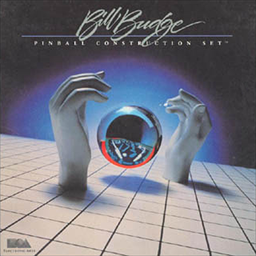
Pinball Construction Set is a video game by Bill Budge written for the Apple II. It was originally published in 1982 through Budge's own company, BudgeCo, then was released by Electronic Arts in 1983 along with ports to the Atari 8-bit family and Commodore 64.

The KoalaPad is a graphics tablet, released in 1983 by U.S. company Koala Technologies Corporation, for the Apple II, TRS-80 Color Computer, Atari 8-bit family, and Commodore 64, as well as for the IBM PC.
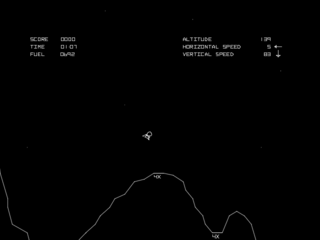
Lunar Lander is a genre of video games loosely based on the 1969 landing of the Apollo Lunar Module on the Moon. In Lunar Lander games, players generally control a spacecraft as it falls toward the surface of the Moon or other astronomical body, using thrusters to slow the ship's descent and control its horizontal motion to reach a safe landing area. Crashing into obstacles, hitting the surface at too high a velocity, or running out of fuel all result in failure. In some games in the genre, the ship's orientation must be adjusted as well as its horizontal and vertical velocities.
Fueled by the previous year's release of the colorful and appealing Pac-Man, the audience for arcade video games in 1981 became much wider. Pac-Man influenced maze games began appearing in arcades and on home systems. Pac-Man was the highest-grossing video game for the second year in a row. Nintendo's Donkey Kong defined the unnamed platform game genre, while Konami's Scramble established forced-scrolling shooters. The lesser known Jump Bug combined the two concepts into both the first scrolling platform game and the first platform shooter. Other arcade hits released in 1981 include Defender, Frogger, and the Galaxian sequel Galaga.

David's Midnight Magic is a pinball simulation video game written by David Snider for the Apple II and published by Broderbund in 1982. The game was published in Europe by Ariolasoft. A port to the Atari 8-bit family was released the same year, then the Commodore 64 in 1983. In 1987 Atari Corporation published a cartridge in the styling of the then-new Atari XEGS.
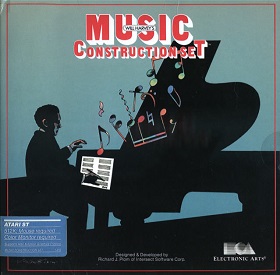
Will Harvey's Music Construction Set (MCS) is a music composition notation program designed by Will Harvey for the Apple II and published by Electronic Arts in 1983. Harvey wrote the original Apple II version in assembly language when he was 15 and in high school. MCS was conceived as a tool to add music to his previously published game, an abstract shooter called Lancaster for the Apple II.

Softalk was an American magazine of the early 1980s that focused on the Apple II computer. Published from September 1980 through August 1984, it featured articles about hardware and software associated with the Apple II platform and the people and companies who made them. The name was originally used on a newsletter of Apple Software pioneer company, Softape, who in 1980 changed its name to Artsci Inc.
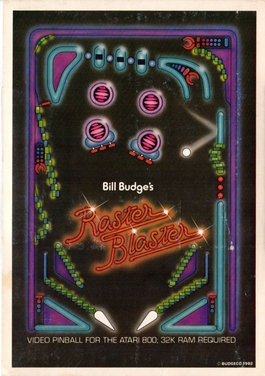
Bill Budge's Raster Blaster is a pioneering home computer pinball simulation written by Bill Budge for the Apple II and published in 1981 by Budge's company, BudgeCo. It was ported to the Atari 8-bit family. Raster Blaster resembles the Williams Firepower table from 1980.

The Prisoner is a 1980 Apple II computer game produced by Edu-Ware. The game was loosely based on the 1960s television series The Prisoner and incorporates that show's themes about the loss of individuality in a technological, controlling society. The player's role is that of an intelligence agent who has resigned from his job for reasons known only to himself, and who has been abducted to an isolated island community that seems designed to be his own personal prison. The island's authorities will use any means—including coercion, disorientation, deception, and frustration—to learn why their prisoner has resigned, and every character, location, and apparent escape route seem to be part of a grand scheme to trick the player into revealing a code number representing the prisoner's reason for resigning. The game occasionally breaks the fourth wall by acknowledging that a game is being played.

Many games, utilities, and educational programs were available for the Atari 8-bit family of home computers. Atari, Inc. was the primarly publisher following the launch of the Atari 400/800 in 1979, then increasingly by third parties. Atari also distributed "user written" software through the Atari Program Exchange from 1981 to 1984. After APX folded, many titles were picked up by Antic Software.

Garry Kitchen's GameMaker is an integrated development environment for the Commodore 64, Apple II, and IBM PC compatibless, created by Garry Kitchen and released by Activision in 1985. It is one of the earliest all-in-one game design products aimed at the general consumer, preceded by Broderbund’s The Arcade Machine in 1982. Several sample files are included: a demo sequence featuring animated sprites and music, a recreation of Pitfall!, and a birthday greeting.
California Pacific Computer Company is a defunct software company that published games and related software for the Apple II family of computers in the late 1970s and early 1980s. California Pacific is best known as the publisher of the first installment of Richard Garriott's popular Ultima game series, and for Super Invader, a Space Invaders clone voted the most popular software of 1978–80.
Dazzle Draw is a raster graphics editor for the Apple IIc and Apple IIe. The program allows users to create bitmap images which can then be printed or used in other programs. Developed by David Snider and released in 1984 by Broderbund, the program is similar to MacPaint, released in early 1984. Snider previously wrote the Apple II pinball game David's Midnight Magic.

Bill Budge's Space Album is a collection of four Apple II action games written by Bill Budge and published by California Pacific in 1980. The games are Death Star, Asteroids, Tail Gunner, and Solar Shootout. Death Star was based around a scenario similar to the Death Star "trench battle" that formed the climax of the 1977 film, Star Wars Episode IV: A New Hope. Asteroids was a variant of the popular arcade video game of the same title.

Night Mission Pinball is a pinball simulation video game published by Sublogic in 1982. It was developed by Bruce Artwick for the Apple II, then ported to the Atari 8-bit family, Commodore 64, and IBM PC.
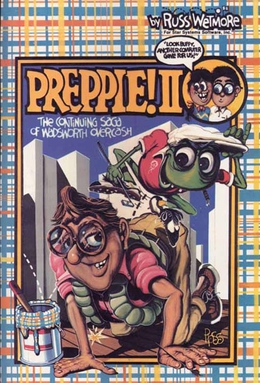
Preppie! II is a video game written by Russ Wetmore for the Atari 8-bit family and published by Adventure International in 1983. Subtitled "The continuing saga of Wadsworth Overcash," it is a sequel to 1982's Frogger-inspired Preppie!. It loosely follows the preppy theme, primarily through a story in the manual, but replaces the country club setting with an abstract, overhead view maze. Some obstacles from the first game appear in the second.
















